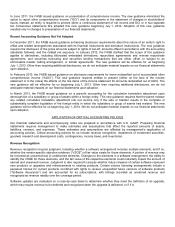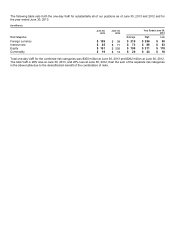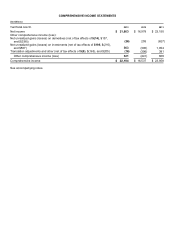Microsoft 2013 Annual Report Download - page 38
Download and view the complete annual report
Please find page 38 of the 2013 Microsoft annual report below. You can navigate through the pages in the report by either clicking on the pages listed below, or by using the keyword search tool below to find specific information within the annual report.The estimates used to calculate the fair value of a reporting unit change from year to year based on operating results,
market conditions, and other factors. Changes in these estimates and assumptions could materially affect the
determination of fair value and goodwill impairment for each reporting unit.
Research and Development Costs
Costs incurred internally in researching and developing a computer software product are charged to expense until
technological feasibility has been established for the product. Once technological feasibility is established, all software
costs are capitalized until the product is available for general release to customers. Judgment is required in determining
when technological feasibility of a product is established. We have determined that technological feasibility for our
software products is reached after all high-risk development issues have been resolved through coding and testing.
Generally, this occurs shortly before the products are released to manufacturing. The amortization of these costs is
included in cost of revenue over the estimated life of the products.
Legal and Other Contingencies
The outcomes of legal proceedings and claims brought against us are subject to significant uncertainty. An estimated loss
from a loss contingency such as a legal proceeding or claim is accrued by a charge to income if it is probable that an
asset has been impaired or a liability has been incurred and the amount of the loss can be reasonably estimated.
Disclosure of a contingency is required if there is at least a reasonable possibility that a loss has been incurred. In
determining whether a loss should be accrued we evaluate, among other factors, the degree of probability of an
unfavorable outcome and the ability to make a reasonable estimate of the amount of loss. Changes in these factors could
materially impact our financial statements.
Income Taxes
The objectives of accounting for income taxes are to recognize the amount of taxes payable or refundable for the current
year and deferred tax liabilities and assets for the future tax consequences of events that have been recognized in an
entity’s financial statements or tax returns. We recognize the tax benefit from an uncertain tax position only if it is more
likely than not that the tax position will be sustained on examination by the taxing authorities, based on the technical
merits of the position. The tax benefits recognized in the financial statements from such a position are measured based on
the largest benefit that has a greater than 50% likelihood of being realized upon ultimate settlement. Accounting literature
also provides guidance on derecognition of income tax assets and liabilities, classification of current and deferred income
tax assets and liabilities, accounting for interest and penalties associated with tax positions, and income tax disclosures.
Judgment is required in assessing the future tax consequences of events that have been recognized in our financial
statements or tax returns. Variations in the actual outcome of these future tax consequences could materially impact our
financial statements.
Inventories
Inventories are stated at average cost, subject to the lower of cost or market. Cost includes materials, labor, and
manufacturing overhead related to the purchase and production of inventories. We regularly review inventory quantities
on hand, future purchase commitments with our suppliers, and the estimated utility of our inventory. These reviews
include analysis of demand forecasts, product life cycle status, product development plans, current sales levels, pricing
strategy, and component cost trends. If our review indicates a reduction in utility below carrying value, we reduce our
inventory to a new cost basis through a charge to cost of revenue. The determination of market value and the estimated
volume of demand used in the lower of cost or market analysis require significant judgment.
























